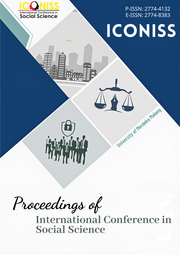Land Zoning Plan to Vertical Development Control with UCA And UPA Concept in Urban Area of Yogyakarta
DOI:
https://doi.org/10.26905/iconiss.v3i1.9083Keywords:
Control, Development, Land zoning, VerticalAbstract
Depok is one of Yogyakarta’s sub-district known as a sub-urban area with massive vertical development. The number of public facilities and infrastructure such as airports, historic buildings, and shopping centers makes it a high potential for vertical development activities. The high potential for economic development increases land development. Meanwhile, the side effect of accelerated development can change the environment to become saturated, slum, and disorganized. For this reason, it is necessary to have an area development control plan that can accommodate economic activities, local community values, and environmental needs to create sustainable development. Land zoning is one of the aspects that is important to keep the vertical development growth up to par. The dynamic demand for urbanism development brings the situation to make legal control of regional development. As a result, this research chose UCA and UPA concepts to solve the problem by purposing the plan (blueprint). Researchers use some theories to bring the concept and qualitatively collect the data. Purposing the plan with those several concepts will keep the region’s vertical development from enormous impacts, such as disaster/mother nature, and citizen mobility in the Depok sub-district. The promotion system can facilitate vertical development that remained friendly in residential as well as commercial activities surrounding this area. By the end of this research and planning, land zoning can increase the value of the economic, social, and ecological in the Depok sub-district.
Downloads
References
Adhitia, R. B. (2012). Perkembangan Fungsi Komersial di Kawasan Taman Kota Kambang Iwak Palembang Provinsi Sumaera Selatan. Skripsi (tidak dipublikasikan). Perencanaan Wilayah dan Kota Universitas Gadjah Mada Yogyakarta.
Anonim, (1997). Kamus Tata Ruang, Direktoral Jendral Cipta Karya, Jakarta.
Anonim, (2003). Introduction of Urban Land Use Planning Sysem in Japan, the City Planning Division, City and Regional Development Bureau, Ministry of Land, Tokyo.
Anonim, (2006). Panduan Penyusunan Peraturan Zonasi Wilayah Perkotaan, Direktorat Jendral Penataan Ruang Departemen Pekerjaan Umum, Jakarta.
Barnett, J. (1982). Introduction to Urban Design. New York: Harper & Row Publishers.
Beame, A. D, (1974), Zoning Handbook A Guide to the New York City Zoning Resolution, New York City Planning Commission, New York.
Bishop, J. (1989). Incentives for learning: Why American high school students compare so poorly to their counterparts overseas. Ithaca, NY: Cornell University, Center for Advanced Human Resource Studies.
Bohl, C. C, (2002), Place Making: Developing Town Centers, Main Streets, and Urban Villages. New York.Urban Land Institute.
Branch, M. C, (1995), Perencanaan Kota Komprehensif Pengantar & Penjelasan, American Planning Association, USA.
Budihardjo, E., & Sujarto, D. (2009). Kota Berkelanjutan (Sustainable City). Bandung: P.T. Alumni.
Danisworo, M. (1991).Teori Perancangan Urban, Program Studi Perancangan Arsitektur Pasca Sarjana ITB: Bandung.
De Chiara, J., & Koppelman, L. (1975). Urban Planning Operatioal Research An Introduction. Mc Graw- Hill. Inc, New York.
Djunaedi, A. (2012). Proses Perencanaan Wilayah dan Kota. Yogyakarta: Gadjah Mada University Press.
Dunkerley, H. B. (ed). (1983). Urban Land Policy: Issues and Opportunities. Washington D.C : IBRD/World Bank.
Harrison, M. L., & Mordney, R. (1987) Planning Control: Philosophies, Prospects, and Practice. London : Croom Helm.
Harvey, David. (1996). Justice, Nature, and the Geography of Difference, Blackwell, Cambridge MA
Hemaputri, R. L., & Haryanto, (2013). Analisis Faktor yang Mempengaruhi Perkembangan Aktivitas Komersil di Koridor jalan D.I Pandjaitan Kota Samarinda. Jurnal Teknik PWK, 2(3).
Jayadinata, J. T. (1986). Tata Guna Tanah dalam Perencanaan Perdesaan Perkotaan & Daerah. Bandung : Penerbit ITB
Khairuddin, (2000), Pembangunan Masyarakat, Liberty, Yogyakarta.
Nugraha, A. A. (2015). Perkembangan Ruang Komersial di Kawasan Jeron Benteng Kota Yogyakarta. Skripsi (tidak dipublikasikan). Perencanaan Wilayah dan Kota Universitas Gadjah Mada Yogyakarta.
Zahnd, M. (1999), Perancangan Kota Secara Terpadu, Yogyakarta : Kanisius.
Keputusan Menteri Perhubungan No 48 Tahun 2002 tentangPenyelenggaraan Bandar Udara Umum
Peraturan Pemerintah Dalam Negeri No. 1 Tahun 2008 tntang Pedoman Perencanaan Kawasan Perkotaan
Peraturan Daerah Kota Yogyakarta Nomor 2 Tahun 2010 tentang Rencana Tata Ruang Wilayah Kota Yogyakarta
Peraturan Daerah Kota Yogyakarta Nomor 11 Tahun 2012 tentang bangunan gedung
Undang – Undang Nomor 7 Tahun 2004 Tentang Sumber Daya Air
Undang – Undang Nomor 24 Tahun 2007 Tentang Penanggulangan Bencana
Undang – Undang Nomor 26 Tahun 2007 Tentang Penataan Ruang
Downloads
Published
Issue
Section
License
Authors who publish in this journal agree to the following terms:
(1)Â Copyright of the published articles will be transferred to the journal as the publisher of the manuscripts. Therefore, the author confirms that the copyright has been managed by the journal.
(2) Publisher of Proceedings of International Conference in Social Science is the University of Merdeka Malang.
(3) The copyright follows Creative Commons Attribution–ShareAlike License (CC BY SA): This license allows to Share — copy and redistribute the material in any medium or format, Adapt — remix, transform, and build upon the material, for any purpose, even commercially.

